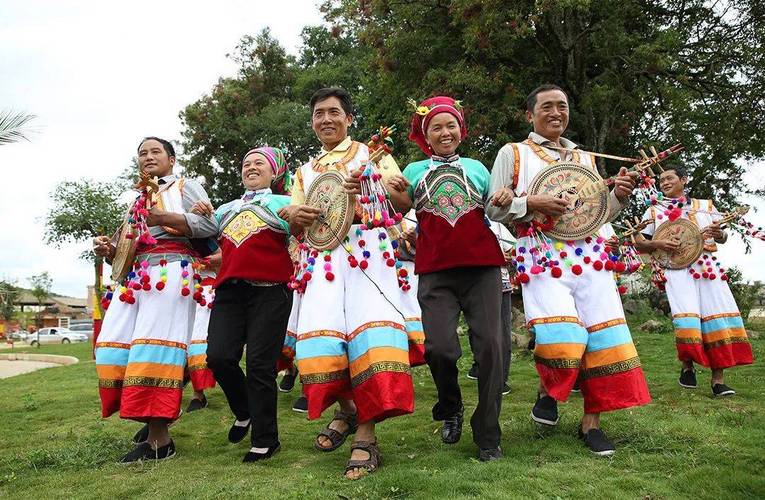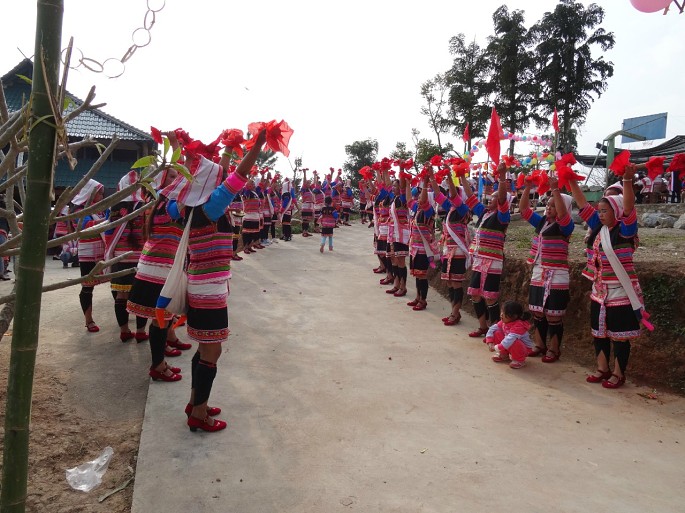
Jinghong Overview
Jinghong Overview will give you a comprehensive understanding of Jinghong in Xishuangbanna Dai Autonomous Prefecture, including the basic information, geographical location, climate and so on. As the prefectural city of Xishuangbanna, Jinghong has jurisdiction over 5 towns, 5 counties and 1 Subdistrict. Lancang- Mekong River irrigates this green land. The river flows through Myanmar, Laos, Thailand, Cambodia and Vietnam and then flows into the Pacific Ocean. It is reputed as "Eastern Danube River".
Basic Information
- Chinese Name: 景洪
- Area: 6958 square kilometers
- Population: 520,000(2011)
- Zip code: 666100
- Dialing code: (+86) 0691
- Location: Southernmost point of Yunnan province
- Administrative Category: County-level City
- Seat of Government: Melong Road, Jinghong City
- Main Ethnic Groups: Dai, Hani, Yi, Lahu, Blang, Jino, Yao, Miao, Hui, Wa, Zhuang and Jingpo
- Main Airport: Gasa International Airport
- Top University: Xishuangbanna Vocational and Technical Institute
- Important Festival and Activities: Water Splashing Festival, Gatangpa Festival
- Famous Attractions:Wild Elephant Valley , Dai Minority Garden at Ganlanba, Xishuangbanna Primeval Forest Park, Manting Park and Xishuangbanna Tropical Flower Garden.
Geography
Jinghong is located at the south of Yunnan Province, the middle of Xishuangbanna Autonomous Prefecture. Jinghong is the political, economic and cultural center of Xishuangbanna Dai Autonomous Prefecture, which is a supernatural oasis in southwest China, while Jinghong is just a bright pearl in the oasis.
Climate and Weather
For its typical geography, Jinghong Climate contains elements of both a tropical wet and dry climate and a humid subtropical climate. Summer is long and there is virtually no "winter" as such; instead, there is a dry season (November thru May) and wet season (June thru October). Annual sunshine hours amount to between 1800 and 2300 and annual rainfall ranging from 1,100 to 1,700 millimetres (43 to 67 in). The coolest month is December and January, averaging 11.6 °C , while the hottest is June, averaging 33.4°C. The average annual temperature in Jinghong is 23.3 °C.
- Dry season (November-May): The weather is hot, T-shirts, shorts and scandals are necessary. It is cool in Januarary, so if you travel to Xishuangbanna in Jan, you should also prepare long sleeves, coat and trousers. In addition, sunglasses, sunscreen, mosquito repellent, sunshade cap and anti-heatstroke drugs are essential.
- Rainy Season (June-October): The weather is hot and humid, and you will feel sweaty. It is recommended to bring a small towel when going out. Umbrella, mosquito repellent, sunscreen and heatstroke prevention drugs (such as Huoxiang Zhengqi Capsule 藿香正气胶囊) are essential.
Best Time to Visit Jinghong
The best time to visit Jinghong is during the dry season (from November to April), when the weather is agreeable and the temperature is mild. Dry season is also the peak tourism time of Jinghong, Xishuangbanna, especially April, for the Water Splashing Festival is celebrated in April. If you would like to taste the various tropical fruit here, traveling during the rainy period from June to September is a good choice.
Administrative Division
Jinghong City administrative division gives you information about places to visit during Xishuangbanna travel. Jinghong city has jurisdiction over 1 subdistrict, 5 towns, 5 townships, 16 neighborhood committees and 81 village committees.
- 1 Subdistrict: Yunjinghong Subdistrict(允景洪街道)
- 5 Towns: Gasa Town(嘎洒镇), Menglong Town(勐龙镇), Menghan Town(勐罕镇), Mengyang Town(勐养镇), Puwen Town(普文镇)
- 5 Townships: Jingha Hani Ethnic Town(景哈哈尼族乡), Jingne Town (景讷乡), Dadugang Town (大渡岗乡), Mengwang Town (勐旺乡), Jinoshan Jinuo Ethnic Town (基诺山基诺族乡)
History of Jinghong
In 1269 of the Yuan Dynasty (1271-1368), Jinghong Kingdom was changed into Cheli Army and People General Government which was re-changed into Cheli Xuanwei Shisi (pacification office) in 1384 of the Ming Dynasty (1368-1644). In 1570, the commissioner of Cheli Xuanwei Shisi divided its territory into 12 Banna (12 parts). In 1927, Cheli Xuanwei Shisi was made as Cheli County, and then was renamed as Jinghong County in 1958. Finally, it was upgraded as Jinghong City in 1993.
More about History of Jinghong
Jinghong Culture
Jinghong Ethnic Culture is diverse and colorful. It is a place where multi-ethnic groups inhabit. Different nationalities create different cultures. Jinghong city offers amazing Dai culture, temple culture, cultures of ethnic festivals, etc. All these will make Xishuangbanna Travel more attractive and impressing.
More about Jinghong Culture
Jinghong Transportation
Air- Xishuangbanna Gasa Airport is the second largest airport in Yunnan, located just five kilometers from the downtown. Flights to Kunming, Shanghai, Chengdu and other major cities in China run regularly. There is one weekly international flight to Luang Prabang.
- Waterway-There are international waterage line to Laos.
- Highway-The speedway from Jinghong to Menghai, Mengla, and Kunming.
- The city has the largest public transportation center in Xishuangbanna and connects travelers to nearby cities, towns and villages.
More about Jinghong Transportation
Things to Do
There are many cultural and scientific institutes here, including Yunnan Institute of Tropical Craps, Yunnan National Laboratory primate Center of China and the largest butterfly farms of China. The city has the most enchanting tropical landscape. The main scenic spots worthwhile visiting are the Peacock Lake, Chunhuan Park, Manjinglan Tourism Village, Folk-Custom garden, Dai Garden (the village of the Dai ethnic group) and Xishuangbanna Primitive Forest Park.
Ethnic People
Dai Minority Nationalities is the majority. Hani people are mainly distributed in the mountainous and semi-mountainous areas such as Menhai, Menglong and Mengla counties. Jino people are mainly living in Jino and Mengwang townships. Blang people are the aborigines of Yunnan Province, mainly distributed in Bulangshan and Xiding Townships, Mengman, Daluo towns. Hui people are concentrated in Menghai and Mengzhe towns.
Jinghong Economy
In 2010, Jinghong's GDP was 8.812 billion yuan, up 14.5% from 2009. Among them, the added value of the primary industry was 2.205 billion yuan, up 8.6% from 2009 (comparable price); the added value of the secondary industry was 2.843 billion yuan, up 20.7% over 2009; the added value of the tertiary industry was 3.765 billion yuan, up 13.8% from 2009. The three industrial structures were adjusted to 25.0:32.3:42.7 from 23.5:33.1:43.4 last year. Per capita GDP (calculated by household registration population) was 22,155 yuan, up 13.3% from 2009. The total fiscal revenue was 1.566 billion yuan, up 19.9% from 2009. The general budget revenue of local finance was 1.199 billion yuan, up 17.2% over 2009. The general expenditure of local finance was 2.233 billion yuan, up 17.6% from 2009. At the end of the year, the balance of various deposits in financial institutions was 16.706 billion yuan, up 29.1% over 2009. The balance of loans from financial institutions was 10.9 billion yuan, up 22.7% over 2009.
Natural Resources in Jinghong
Biological Resources
Xishuangbanna boasts the most well-preserved area of China's tropical ecosystem, with a forest area of 1.516 million hectares. There are 6 national nature reserves of 4.02 million mu in Mengyang, Mengla, Menglun, Shang Yong, Mangao and Naban River basins, of which 700,000 mu are well-protected virgin forests with more than 5,000 species of higher plants, 153 species of which are endemic, such as Wangtianshu, Banna Greengage and Yunnan Peanut Crown. 134 species of endangered plants, such as Southwest Purple Micro, Tieli Wood, Yunnan Gmelina, Yunnan Mayterus Hookeri Loes, etc. A large number of plant species grow alternately, forming a complex and diverse vegetation landscape such as tropical rain forest, tropical monsoon forest, subtropical evergreen broad-leaved forest, moss evergreen broad-leaved forest, coniferous broad-leaved mixed forest, bamboo-wood mixed forest, shrub forest, etc. There are 1724 kinds of Chinese herbal medicines in Xishuangbanna, and more than 500 kinds have been identified.
Water Resources
Jinghong city boasts 3.31 billion cubic meters of water resources, including 2.025 billion cubic meters of surface water.
Mineral Resources
The mineral resources in Jinghong City mainly include iron, manganese, coal, tin and 15 exposed hot springs.
Keep Reading

 7 Days GolfingTour
7 Days GolfingTour
 8 Days Group Tour
8 Days Group Tour
 8 Days Yunnan Tour
8 Days Yunnan Tour
 7 Days Shangri La Hiking
7 Days Shangri La Hiking
 11 Days Yunnan Tour
11 Days Yunnan Tour
 6 Days Yuanyang Terraces
6 Days Yuanyang Terraces
 11 Days Yunnan Tour
11 Days Yunnan Tour
 8 Days South Yunnan
8 Days South Yunnan
 7 Days Tea Tour
7 Days Tea Tour
 8 Days Muslim Tour
8 Days Muslim Tour
 12 Days Self-Driving
12 Days Self-Driving
 4 Days Haba Climbing
4 Days Haba Climbing
 Tiger Leaping Gorge
Tiger Leaping Gorge
 Stone Forest
Stone Forest
 Yunnan-Tibet
Yunnan-Tibet
 Hani Rice Terraces
Hani Rice Terraces
 Kunming
Kunming
 Lijiang
Lijiang
 Shangri-la
Shangri-la
 Dali
Dali
 XishuangBanna
XishuangBanna
 Honghe
Honghe
 Kunming
Kunming
 Lijiang
Lijiang
 Shangri-la
Shangri-la
 Yuanyang Rice Terraces
Yuanyang Rice Terraces
 Nujiang
Nujiang
 XishuangBanna
XishuangBanna
 Spring City Golf
Spring City Golf
 Snow Mountain Golf
Snow Mountain Golf
 Stone Mountain Golf
Stone Mountain Golf






